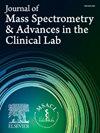A rapid method for determination of rosuvastatin in blood plasma with supported liquid extraction
IF 3.4
4区 医学
Q2 MEDICAL LABORATORY TECHNOLOGY
Journal of Mass Spectrometry and Advances in the Clinical Lab
Pub Date : 2025-04-01
DOI:10.1016/j.jmsacl.2025.04.003
引用次数: 0
Abstract
Introduction
Accurate measurement of rosuvastatin in plasma is critical for effective patient management and treatment monitoring following myocardial infarction (MI). Expensive solid-phase extraction (SPE) and time-consuming liquid–liquid extraction (LLE) have been established for quantifying rosuvastatin. Supported liquid extraction (SLE) could offer a rapid, cost-effective alternative.
Objectives
This study aimed to develop and validate a rapid, cost-effective, accurate, and precise method for quantifying rosuvastatin in high-dose plasma samples from patients following MI.
Methods
Rosuvastatin was extracted from EDTA plasma using SLE and quantified with LC-MS/MS with positive electrospray ionization. The method was validated according to ICH M10 guidelines, focusing on selectivity, matrix effect, accuracy, precision, linearity, and carryover. Rosuvastatin-D6 was used as an internal standard. Additionally, thirty plasma samples from patients on high-dose rosuvastatin therapy (20 or 40 mg/day) following MI were analyzed by both LLE and SLE methods and compared.
Results
The method was successfully validated, demonstrating linearity across a range of 0.1 ng/mL to 50 ng/mL. Compared to the LLE method, SLE achieved superior extraction recovery (96.3 % vs. 60 %) and precision (RSD: 11.9 % vs. 13.6 %) at 0.3 ng/mL rosuvastatin, with a lower absolute matrix effect (12.7 % vs. −36.7 %). Accuracy was comparable (109.3 % vs. 92.8 %). Although SLE involves higher initial costs, it significantly enhances throughput, reduces solvent usage, and minimizes contamination and equipment wear.
Conclusion
This study validates SLE as a superior method for quantifying rosuvastatin in plasma, outperforming LLE in recovery, reproducibility, and automation. SLE offers greater accuracy and reliability, making it ideal for high-throughput applications.
支撑液体萃取法快速测定血浆中瑞舒伐他汀的含量
准确测量血浆瑞舒伐他汀对心肌梗死(MI)后患者的有效管理和治疗监测至关重要。建立了昂贵的固相萃取法(SPE)和耗时的液液萃取法(LLE)来定量瑞舒伐他汀。支持液体萃取(SLE)是一种快速、经济的替代方法。目的建立并验证一种快速、经济、准确、精确的方法,用于急性心肌梗死患者高剂量血浆样品中瑞舒伐他汀的定量。方法采用SLE法从EDTA血浆中提取瑞舒伐他汀,并采用电喷雾正离子化LC-MS/MS定量。根据ICH M10指南对该方法进行验证,重点关注选择性、基质效应、准确度、精密度、线性和结转。以瑞舒伐他汀d6为内标。此外,采用LLE和SLE方法对心肌梗死后接受高剂量瑞舒伐他汀治疗(20或40 mg/天)的患者的30份血浆样本进行分析和比较。结果该方法在0.1 ng/mL ~ 50 ng/mL范围内呈线性关系。与LLE法相比,0.3 ng/mL瑞舒伐他汀的SLE提取回收率(96.3% vs. 60%)和精密度(RSD: 11.9% vs. 13.6%)更高,绝对基质效应更低(12.7% vs.−36.7%)。准确率相当(109.3%对92.8%)。虽然SLE涉及较高的初始成本,但它显著提高了产量,减少了溶剂的使用,并最大限度地减少了污染和设备磨损。结论本研究验证了SLE作为血浆中瑞舒伐他汀定量的优越方法,在回收率、重现性和自动化方面优于LLE。SLE提供更高的准确性和可靠性,使其成为高通量应用的理想选择。
本文章由计算机程序翻译,如有差异,请以英文原文为准。
求助全文
约1分钟内获得全文
求助全文
来源期刊

Journal of Mass Spectrometry and Advances in the Clinical Lab
Health Professions-Medical Laboratory Technology
CiteScore
4.30
自引率
18.20%
发文量
41
审稿时长
81 days
 求助内容:
求助内容: 应助结果提醒方式:
应助结果提醒方式:


